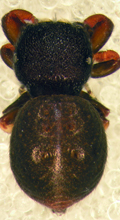Latest News Archive
Please select Category, Year, and then Month to display items
04 September 2019
|
Story Rulanzen Martin
|
Photo Sonia Small

With the second semester well underway, you may feel overwhelmed by the academic pressure and you aren’t sure how to find your way out of this maze. Some first-years are still trying to cope with the hectic academic workload, and our soon to be graduates are contemplating how they will find their feet in the post-university world.
The new edition of Kovsie Advice by the Advising Team in the Centre for Teaching and Learning (CTL) would like to help you get ready for the busy academic times ahead. But they would also like to dedicate this edition to helping you align your tasks and efforts with the end goal – that dream job!
In this edition, ideas and resources are shared to help you align your academic journey with your career aspirations.
Enjoy the journey!
The UFS Advising team
UFS entomologists describe a new spider species
2014-02-19
|
 |
It is about 3mm in size and almost looks like a ladybird, but this new spider is the cause of great excitement at the University of the Free State’s (UFS’s) Department of Zoology and Entomology.
The new species of spider, now known as Rhene amanzi, was recently described for the first time and was ‘introduced’ to other arachnologist at the recent congress of the African Arachnology Society at Amanzi Private Reserve.
Dr Charles Haddad, senior lecturer in the UFS’s Department of Zoology and Entomology, said they already stumbled upon the male spider in 2010 when a student was doing research at the reserve. After a very long process, the spider was described and a couple of weeks ago, whilst at the congress, they also found the female.
“Up to now we only know that the spider lives in trees in the Brandfort area. The range could be wider, but since it was only described recently, other arachnologists will only now be able to identify accurately.”
Dr Haddad says they still have to determine how many eggs the female is able to lay, what the spider’s life cycle looks like and what their habitual preferences are.
“What we do know is that it probably isn’t poisonous and that the spider imitates a ladybird in order to protect itself against predators.”